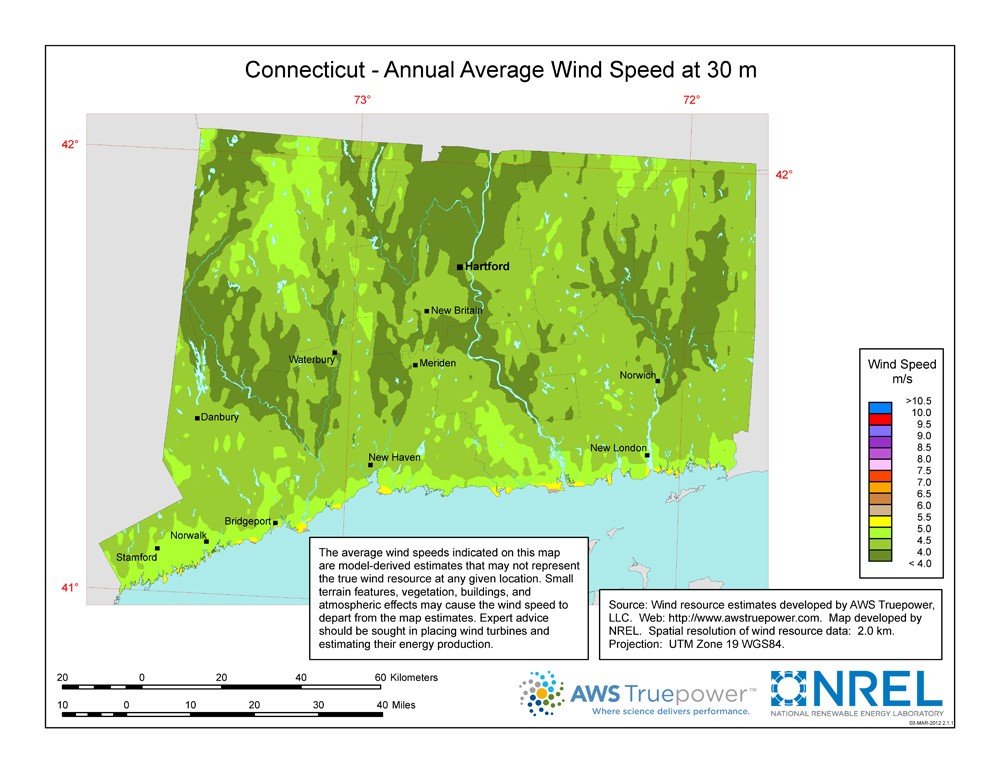Wind Energy in Connecticut
Find wind data and information in Connecticut, including maps, capacity, ordinances, and more in these areas:
Capacity & Generation
Installed Capacity 5 MW Source: American Clean Power Association
MW Under Construction 0 MW Source: American Clean Power Association
Based on EIA data from 2024
U.S. Wind Turbine Database

The United States Wind Turbine Database (USWTDB) provides the locations of land-based and offshore wind turbines in the United States, corresponding wind project information, and turbine technical specifications. The creation of this database was jointly funded by the U.S. Department of Energy Wind Energy Technologies Office via the Lawrence Berkeley National Laboratory Electricity Markets and Policy Group, the U.S. Geological Survey Energy Resources Program, and the American Wind Energy Association.
Wind Education & Training
Career training and projects at schools in Connecticut.
Training Locations
University of Connecticut Department of Marine Sciences
University of Connecticut School of Law
Wind for Schools Project Locations
There are no Wind for Schools projects in Connecticut.
Policies & Incentives
Connecticut Incentives
View current Connecticut renewable energy incentives on the DSIRE website.
Renewable Portfolio Standard
There are no wind ordinances in Connecticut.
See ordinances in other states or check the DSIRE database of federal and state renewable energy policies and incentives.
CT Cities with 100% Renewable Energy Commitments
There are no cities with 100% renewable energy commitments in Connecticut.
WETO R&D Projects

To view a list of wind research and development projects in Connecticut funded by the U.S. Department of Energy’s Wind Energy Technologies Office, visit the Wind R&D Projects Map and select Connecticut from the dropdown menu.
Wind Turbine Component Manufacturers

The National Renewable Energy Laboratory’s Wind Prospector tool is a web-based Geographical Information System that supports resource assessment and data exploration for wind development. Wind Prospector includes a data layer dedicated to the locations of U.S. wind turbine and component manufacturing and supply chain facilities. Corporate headquarters, service facilities, material suppliers, R&D and logistics centers, and smaller component manufacturers (e.g., bolt manufacturers) are not included. The list of facilities included is not intended to be exhaustive.
Connecticut Offices & Organizations
Clean Energy Group
Clean Energy Group is a leading national, nonprofit organization working on innovative policy, technology, and finance programs in the areas of clean energy and climate change. The group's projects concentrate on climate and clean energy issues at the state, national, and international levels and include stakeholders from governments and the private and nonprofit sectors. Clean Energy Group assists states to create and implement innovative practices and public funding programs for clean energy project deployment; creates networks of U.S. and international policy makers to address climate stabilization strategies; and advances effective distributed innovation theories, finance, and commercialization tools for new climate technologies.
Connecticut Department of Energy and Environmental Protection
The Connecticut Department of Energy and Environmental Protection is charged with conserving, improving, and protecting Connecticut's natural resources and environment as well as making cheaper, cleaner, and more reliable energy available for the state's residents and businesses. The energy branch includes the Public Utilities Regulatory Authority (formerly the Department of Public Utility Control), which reviews rates for electricity and other utilities and includes information about the Connecticut Renewable Portfolio Standard.
Northeast Regional Planning Body
The Northeast Regional Planning Body is responsible for developing New England’s ocean plan. The National Ocean Policy, established by Presidential Executive Order in 2010, called for the formation of nine Regional Planning Bodies to better manage the nation’s oceans and coasts. New England was the first region in the nation to respond to this call, launching the Northeast Regional Planning Body in 2012. The Northeast Regional Planning Body includes representatives from the six New England states, 10 federally recognized tribes, 10 federal agencies, and the New England Fishery Management Council. The Regional Planning Body has no authority to create new regulations. Its mandate is to create a plan and oversee its implementation, with many opportunities for public participation.



